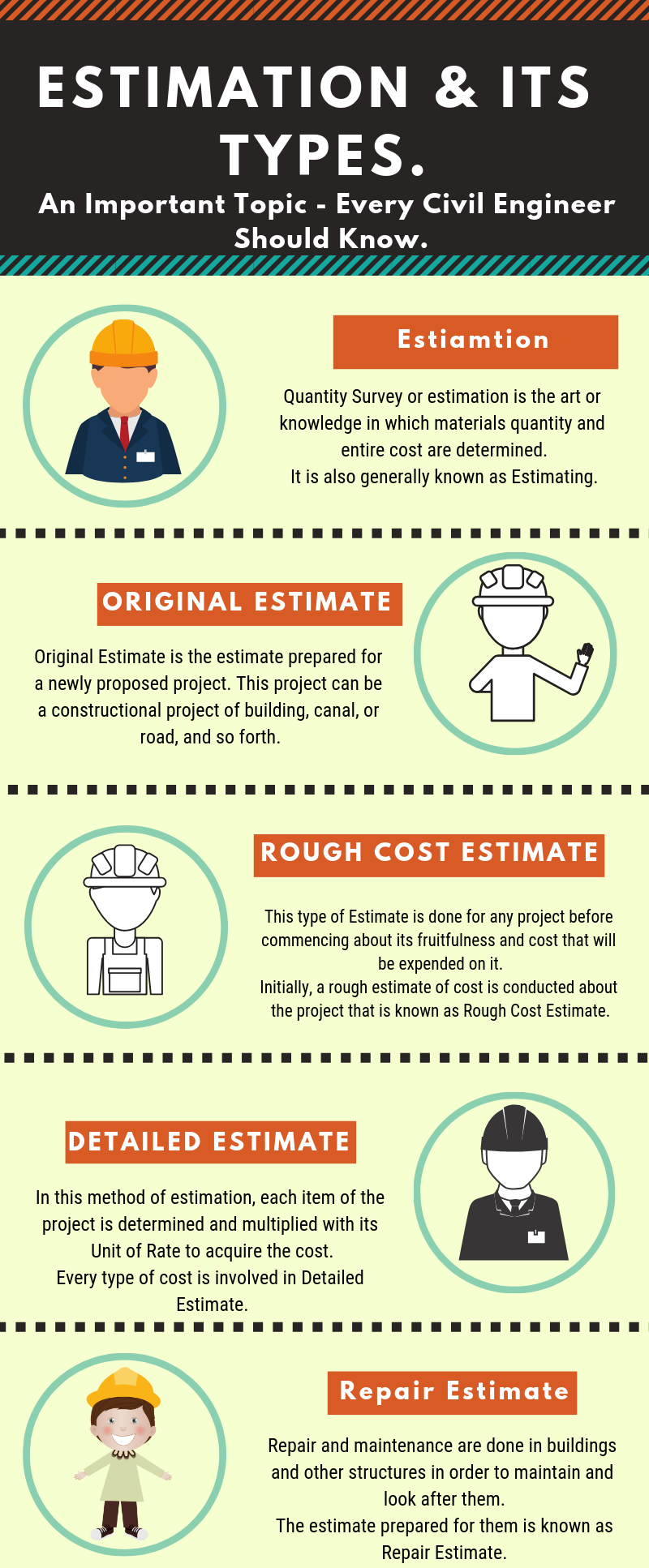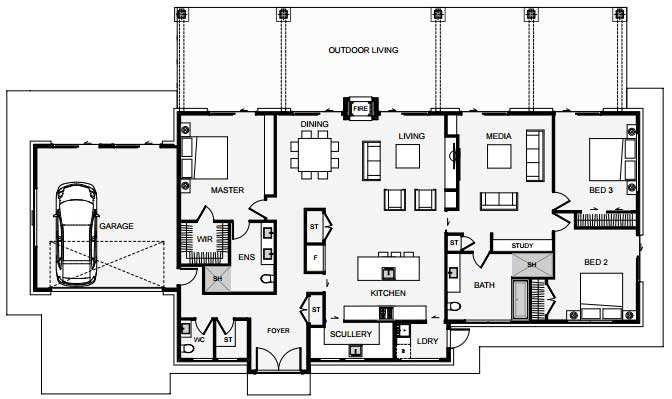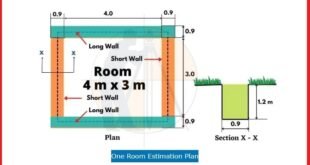A Guide on Estimation, Quantity Survey – Types of Estimate.
In this article, you are going to learn in details about the Estimation, Quantity Survey And types of Estimate in Construction Project.
You will also learn rough Cost Estimate for buildings, Roads and Highways, Irrigation Channels, Bridges and Culverts, Water supply, Water tanks, Railway tracks.

What is Estimation, Quantity Survey ?
Before commencing work over the project, quantity for all materials and its entire cost is determined.
Therefore, Quantity Survey or estimation is the art or knowledge in which materials quantity and entire cost are determined.
It is also generally known as Estimating.
Quantity survey plays a vital role in estimation and construction of any relevant project.
It will help in the determination of all related applicable costs and materials quantity so that all those factors are determined, and funds are released for the project in case if acceptable.
If funds are less, then certain alterations can be conducted so that the project can span within the fixed funds.
These alterations can be brought in the specifications of the project, or the project is conducted in stages so that the project can end within the released funds.
The project should not be underacted in any case.
Estimation is conducted in two ways despite the nature of the project whether the project is of construction, sewerage system, canal digging, or road construction, & so forth.
Initially, Rough Cost Estimate is conducted that will help in the determination of the cost.
Finally, the Detailed Estimate is conducted if funds are released.
Learn More
How to calculate the number of bricks in 1 CFT wall
Quantity Surveyor is the person who estimates.
This person is also known as Evaluator or Estimator.
Estimation cannot be done without understanding the drawing of the relevant project.
One should be skilled in understanding and reading the drawings.
Intended to be skillful in Quantity Surveying.
Data for Estimate.
The following data is imperative for estimation.
1. Drawings.
2. Specifications.
3. Rates.
1. Drawings.
The estimate is prepared according to the drawings.
Drawings depict heights, lengths, and thicknesses of different parts of the project.
Size of every component of the project is shown in drawing and estimate is prepared accordingly.
Plan, Elevation, and Sectional Elevation are common forms of drawings prepared in the process of building estimation.
2. Specifications.
Specifications are appointed along with drawings for the depiction of the project quality.
For Example , a drawing will represent the size of the door, but it cannot represent certain elementary factors such as door type and timber type, etc.
Timber comes in different types with different prices.
All these factors are depicted by specifications.
Specifications have two types.
-
a. General Specifications.
-
b. Detailed Specifications.
a. General Specifications:
General Specifications are also known as Brief Specifications.
They are used to show aspect, standard, and type of constructional work.
They would depict the general classifications of the constructional work of the project.
These specifications are used to establish the standards of the constructional work that will help in establishing Detailed Estimate.
Learn More
Calculation For Road Work
b. Detailed Specifications:
Detailed Specifications depict characteristics, quantity, ratio, and formation method of the material used in construction work in the detailed description.
Each component of the constructional work is detailed separately with the help of Detailed Specifications.
Therefore, all aspects establishing standards and quality of the constructional work are disclosed.
Hence, It will assist in Detailed Estimate.
Detailed Specifications of the items employed in ordinary projects are printed that are used for contracts.
These specifications are called Standard Specifications.
3. Rates.
Accurate rates of material and construction work are required for accurate estimation.
These rates must rely on reality.
Multiplication of rates with the magnitude of material or construction work will result in cost estimation of the project.
Rates of material or constructional work can be determined from Schedule of Rates of different public and private departments, or completed constructional work can be analyzed to get all required rates.
Rates include Material Charges, Carriage Charges, and Labor Charges, etc.
Learn More
-
How To Measure Quantity Of Sand In Truck & HAIWA
-
Principles Of Chain Surveying
-
Super-elevation And Design Formula | Advantages | Highway Engineering
Types of Estimate in Civil Engineering.
An estimate has basic two types as follows.
1. Original Estimate.
2. Repair Estimate.
So, Let’s describe the types of estimate in details.

1. Original Estimate.
Original Estimate is the estimate prepared for a newly proposed project.
This project can be a constructional project of building, canal, or road, and so forth.
In other words, if these projects are commenced from scratch then estimate proposed for them will be Original Estimate.
It is done in two ways as follow.
a. Rough Cost Estimate.
b. Detailed Estimate.
a. Rough Cost Estimate.
This type of Estimate is done for any project before commencing about its fruitfulness and cost that will be expended on it.
Initially, a rough estimate of cost is conducted about the project that is known as Rough Cost Estimate.
If the project is proposed for taking financial advantages, then expected financial income and rough cost estimate is compared in this type of estimate.
If the project is not proposed for taking financial advantages, then its necessity and vitality are compared in this type of estimate.
Rough Cost Estimate is made by comparison of cost expended over former project experiments and undergoing proposed project.
It includes the price of the plot for the project, the cost likely to be expended over the building, water supply and cost of sanitary, provision of gas and electricity.
Rough Cost Estimate also includes 5 to 10 percent’s of additional charges that have to be made on urgent basis during a project, and they are not obvious before project commencement.
These expenses are known as Contingencies.
Rough Cost Estimate is conducted for Administrative Approval.
It is conducted in a different manner: for different types of projects.
Some of the examples are as follow.
Learn More
How To Calculate the Volume And Weight of Asphalt For Road Construction
a. For Buildings.
Different methods are used for conducting Rough Cost Estimate for buildings.
Most famous methods have been explained below.
i. Per Unit Number.
In this method of Rough Cost Estimate for building, the cost estimate is done per unit number according to the aspect of the project.
For example, this method will take account of per students cost in case of school construction, per bed in case of a hospital, and per seat in case of cinema or theater.
Per unit rate is established respecting certain factors such as material and labor etc.
ii. Plinth Area Basis.
Rough Cost Estimate of the building is generally conducted by Plinth Area Basis method.
In this method, the entire proposed constructing area of the building is determined.
This area is known as Plinth Area.
Plinth area will include the area for all the types of rooms, verandas, and walls, etc.
This area is determined by finding all the measurements over the Plinth Area of the building.
Then, Plinth Area is multiplied by the appropriate rates.
This rate is established by observing material intended to be used in the building and its specifications.
The rates can be found by the already constructed buildings in the area, and whereabouts.
Hence, acquired expenditure will be proposed expenditure of the construction of the building.
It will include the provision of gas and electricity, sewerage and all related facilities.
These expenses are usually retained in percentage manner as follow.
-
Water Supply and Sanitary = 8%.
-
Electrification = 8%.
-
Gas Supply = 4%
All these expenses that are paid over facilities are accumulated with the cost paid for the construction of the building.
Subsequently, Contingencies are added up to the final submission.
Contingencies may vary from 5 to 10 percent’s of the overall cost of the building.
Finally, Rough Cost Estimate, for the building will be ready.
10% profit for contractor must be added in overall cost if the project has to be done by contract.
In the case of a multi-storied building, separate cost is determined for each story.
If the drawing of the building is not available or not yet prepared then area of the required rooms is determined, and 30 to 40 percent area is added up for passages and verandas.
Ultimately, Plinth Area is determined. Rough Cost Estimate can be found by this area as well.
Other Post
-
What Is The Best Concrete Mix Ratio For Roof Slab, Beam & Column
-
What Is The Hidden Beam or Concealed Beam – Purpose & Advantages
-
How To Calculate The Length Of Roof Rafters
iii. Cube Rate Estimate.
In this method of Rough Cost Estimate, the total volume of the proposed building is determined.
Then it is multiplied by the Rate Per Unit Volume, and the overall cost of the building is found.
Outer measurement of the building is acquired for finding the volume of the building.
These measurements include length, height, and width of the building.
All these measurements are multiplied together to get the volume of the building.
The height of the building starts from the plinth to the upper surface of the floor of the building.
Foundation and Parapet are not included in it.
Rate Per Unit Volume is selected according to the type of the building and related specifications.
These rates can be established also by already constructed buildings in area and whereabouts.
Cube Rate Estimate method is the best for establishing Rough Cost Estimate as it also involves the height of the building too.
iv. Per Unit Length of Wall.
In this method of Rough Cost Estimate, lengths of different walls are found separately.
Then the cost of Unit Length of each wall is determined.
This cost is determined separately for foundation and Super Structure.
Foundation cost will include the cost of the Damp Proof Course, the cost of digging and filling, etc. as well.
Super Structure cost includes the cost of masonry, wood crafting, roofing, and finishing, etc.

b. For Roads and Highways.
Rough Cost Estimate of the roads and highways is established per kilometer.
Cost of per kilometer is assumed by the type of road or highways being constructed.
This cost is established by the width of the road, the material used in the road, and the design of the road.
The overall cost of the road is acquired by multiplying entire road length with the Rate Per Unit Length of the road.
Learn More
What Is The Standard Dimensional Requirements of building Components
c. For Irrigation Channels.
Rough Cost Estimate for irrigation channel is prepared in two ways.
In a first way, per kilometer expenditure over the irrigation Channel is established.
Then it is multiplied by the total length of the canal to get the overall cost.
In a second way, the overall cost of the irrigation channel is established with respect to the harvesting area intended to be watered by the proposed irrigation channel.
In this method, per acre cost or expenditure is determined.
Then it is multiplied by the total area to get the overall cost of the irrigation channel.
d. For Bridges and Culverts.
Cost of small culverts is determined per culvert cost.
Major culverts, bridges cost is determined per meter span of the culvert or bridge.
e. For Water Supply or Sanitary Line.
Two methods are ensured for Rough Cost Estimate of Water Supply and Sanitary Pipeline.
In the first method, Cost Per head is established for the entire region and this cost is multiplied with the entire region population to get the overall cost for Water Supply and Sanitary Pipeline.
In the second method, Cost Per Acre is established for the entire region and this cost is multiplied with the entire area of the region to get the overall cost for Water Supply and Sanitary Pipeline.
f. For Overhead Water Tank.
Constructional cost of the over-head water tank is determined by its capacity of water storage.
In order to prepare Rough Cost Estimate, Cost Per Liter is established for over-head water tank with respect to height and constructional method of the over-head water tank.
Subsequently, the cost of the tank is found by multiplying liters with the measurement of the capacity.
g. For Railway Track.
Rough Cost Estimate is established per kilometer for construction of railway tracks.
Cost Per Kilometer is established with respect to railways line gauge, rail, and type of sleeper.
Then this cost is multiplied by the length of railway track to get the overall Rough Cost Estimate.
Learn More
How To Calculate The Tile Flooring Cost Per Square Feet
b. Detailed Estimate.
In this method of estimation, each item of the project is determined and multiplied with its Unit of Rate to acquire the cost.
Every type of cost is involved in Detailed Estimate.
Therefore, it is considered a better estimation method.
Detailed Estimate is conducted to get the approval of Technical Sanction of the related project.
The following data is included in this type of estimate.
-
Project Report.
-
Specifications.
-
Detailed Drawing.
-
Design Data.
-
Rates.
This estimate is also conducted for requiring tender so that the project can be completed.
Detailed Estimate is also prepared for other purposes other than Original Building as follow.
-
Revised Estimate.
-
Supplementary Estimate.
-
Revised and Supplementary Estimate.
a. Revised Estimate.
Revised Estimate is prepared when diversion more than 5 percent occurs in the Detailed Estimate.
Diversion occurs due to the fluctuation of prices.
Revised Estimate is also prepared if changes are made in project design of the already prepared Revised Estimate and ultimately Technical Sanction has sought again.
This estimate is conducted like Original Estimate.
Comparative Statement is also attached to Revised Estimate that will clarify the price fluctuation in each item.
b. Supplementary Estimate.
If construction work of the project has been started and change in design has been felt,
..and expenditure due to design changes cannot be covered within approved funds then an additional estimate is prepared which is known as Supplementary Estimate.
The procedure of Supplementary Estimate will be similar to that of procedure for Original Estimate.
A report is prepared along with the Supplementary Estimate that will explain the necessity of alteration or addition.
This estimate will include already approved estimate and Supplementary Estimate.
c. Revised and Supplementary Estimate.
Sometimes changes or additions are required in already prepared estimate in the project, and these changes are caused due to prices diversion of more than 5 percent.
Alteration in cost is brought about by design changes in projector price fluctuation of the items.
If estimate shows the involvement of additional cost more than 5 percent before the commencement of project or during construction of the project,
then divisional officer (XEN) has the authority to prepare the estimate for the project from scratch and acquire new Technical Sanction for the project.
This new estimate will be known as Revised and Supplementary Estimate.
If the cost of altered estimate comes lower than the prior estimate, then such estimate will be known as Reduced Estimate.
Learn More
How to Calculate the Cost of Paint for one Room
2. Repair Estimate.
Repair and maintenance are done in buildings and other structures in order to maintain and look after them.
The estimate prepared to find the cost applying over the repair.
This estimate is known as Repair Estimate.
Procedure for Repair Estimate is similar to that of procedure for Detailed Estimate.
Repair Estimate of the building includes Whitewashing, Paint and, other maintenances.
Road repair will include filling up patches showed up in the surface of the road, ensuing rigidness of the road banks and footpath maintenance, etc.
Different types of Repair Estimates have been listed below.
-
Annual Repair Estimate.
-
Quadrennial Repair Estimate.
-
Special Repair Estimate.
i. Annual Repair Estimate.
Buildings and other structures are repaired every year to keep them maintained and usable.
Estimate prepare for such repair is known as Annual Repair Estimate.
This estimate will include whitewashing and other small repairs. 1 to 1-1/2 percent budget of the overall cost is kept for this purpose.
Road edges and shoulders are repaired and maintained every year as annual repair.
The procedure for Annual Repair Estimate will be similar to that of procedure for Detailed Estimation.
ii. Quadrennial Repair Estimate.
Special repair is done after every four years despite annual repair which is known as Quadrennial Repair.
It includes painting and repairing of spoiled plaster.
Despite, it includes repairing of doors and windows.
The procedure for Quadrennial Repair Estimate will be similar to that of procedure for Detailed Estimation.
Other Post
-
Calculate The Cost Of Filling A Plot With Construction Soil (moo-rum)
-
What Is Difference Between P.P.C And O.P.C Cement
iii. Special Estimation.
Tenure is not fixed for special repair.
However, repairing of damages of buildings and other structures caused by earthquake, flood and other accidents is done in special repair.
Despite, buildings and other structures also breath sever damages and miserable status due to continuous and long usage that are repaired especially to make them livable and usable.
The special repair will include removing of spoiled floor or roof and constructing a new one;
removing broken doors and windows, and wood crafting a new one, removing the spoiled plaster and plastering new one, etc.
Road special repair will include filing up patches showed up in the surface of the road ensuring rigidness of the road banks and footpath maintenance etc.
Other Post
-
How to calculate the number of bricks in 1 CFT wall.
-
How to Calculate the Cost of Paint for one Room
-
How To Calculate The Cement Bags Required For 2000 sq. ft. House
 Surveying & Architects A unique platform of Civil Engineering
Surveying & Architects A unique platform of Civil Engineering

One comment
Pingback: How to calculate the Quantity of Earthwork in the Road - Surveying & Architects